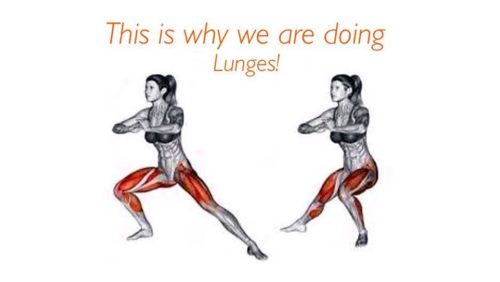1. Forward Lunges
Benefits: While forward lunges hit your glutes and hamstrings, this variation—often just called the plain ol’ lunge—also hones in on your quads for awesome thigh strength and definition, Perkins says.
Instructions: Stand tall with your feet hip-width apart. Place your hands on your hips, over head, or grab some weights, and take a slow, controlled step forward with your right leg. Keeping your spine tall and the weight in your heels, lower your body until both your front and back legs form 90-degree angles, and your knees are directly over your ankles. Pause, then bring your right leg backward to return to start. Make sure not to wobble! Step forward with your left leg and repeat.
2. Reverse Lunges
Benefits: A great cross-training move, throwing your lunges in reverse takes the focus off of your quads and trains your hamstrings and glutes in ways other exercises don’t, Perkins says. Some women also find that they’re easier on the knees.
Instructions: Stand tall with your feet hip-width apart. Place your hands on your hips, over head, or grab some weights, and take a slow, controlled step backward with your right leg. Keeping your spine tall and the weight in your heels, lower your body until both your front and back legs form 90-degree angles, and your knees are directly over your ankles. Pause, then bring your right leg forward to return to start. Again, no wobbling. Step forward with your left leg and repeat.
3. Side Lunges
Benefits: If you’re like most women, your workouts rarely take you from side to side, Perkins says. This move does just that to strengthen the glute medius, which is critical to hip stability and fending off running injuries.
Instructions: Stand tall with your feet togehter. Place your hands on your hips, over head, or grab some weights, and take a big slow and controlled step to the right with your right leg, making sure to land flat on your foot. Keeping your chest up and the weight in your heels, push your hips back, bend your right knee, and lower your body until your right leg is just above parallel to the floor, and your right knee is directly over your ankle. Your left leg should stay straight throughout the entire movement. Pause, then bring your right leg back to start. Step sideways with your left leg and repeat.
4. Walking Lunges
Benefits: The most functional of lunge variations, this one works your muscles similarly to how you walk and run, Perkins says. It is difficult though, so you may want to work up to it starting with forward lunges.
Instructions: Stand tall with your feet hip-width apart. Place your hands on your hips, over head, or grab some weights, and take a slow, controlled step forward with your right leg. Keeping your spine tall and the weight in your heels, lower your body until both your front and back legs form 90-degree angles, and your knees are directly over your ankles. Pause, then take a big step forward with your left leg. Continue alternating to move yourself forward across the floor.
5. Isometric Lunges
Benefits: Holding a lunge is no easy task, but it’s one best left to rehab situations, Perkins says. For instance, if you’re recovering from a knee injury. Also, if you notice any weak spots during your forward, backward, or walking lunges, getting into an isometric lunge and holding your most troublesome position can help you strengthen your legs when they’re bent at that exact angle, she says.
Instructions: Stand tall with your feet hip-width apart. Place your hands on your hips, over head, or grab some weights, and take a slow, controlled step forward with your right leg. Keeping your spine tall and the weight in your heels, lower your body until you reach your desired depth and hold as long as you can without wobbling or breaking form. Bring your right leg back to start. Step forward with your left leg and repeat.
A general word on weights: Perform these lunges for four weeks using only your bodyweight before adding dumbbells or kettlebells into the mix, Perkins recommends. Start by adding 10 pounds, and then increasing the weight by 10-pounds as you feel comfortable.



Post your comment